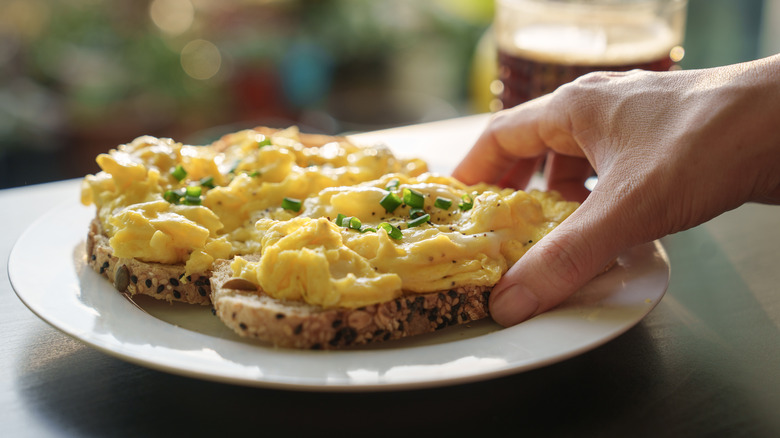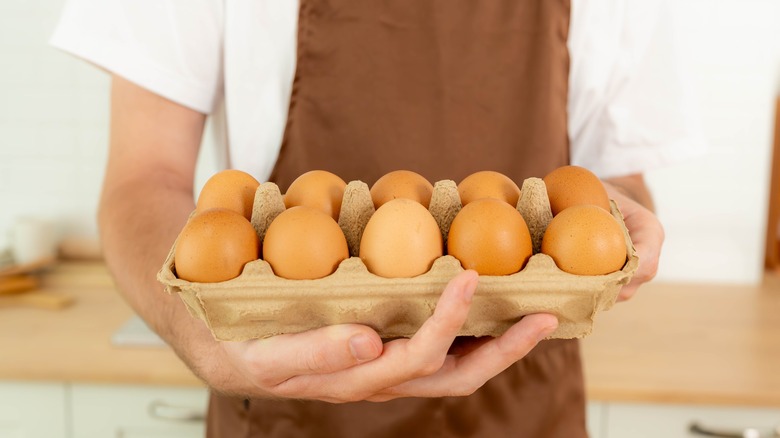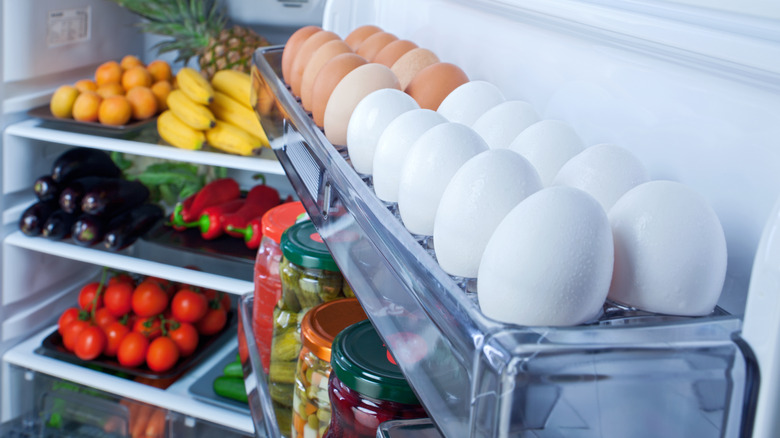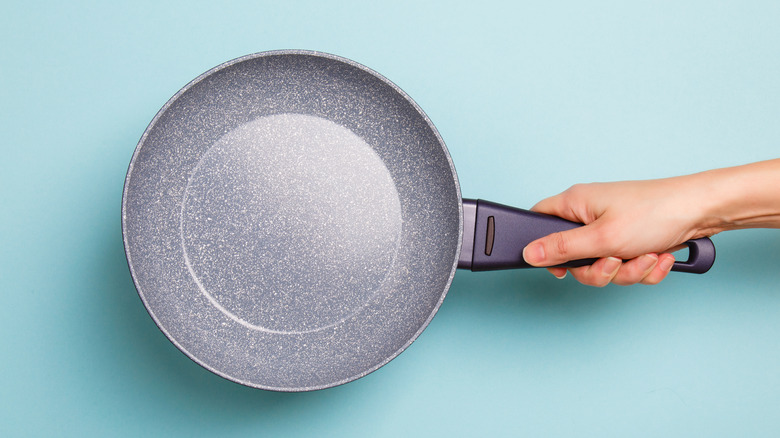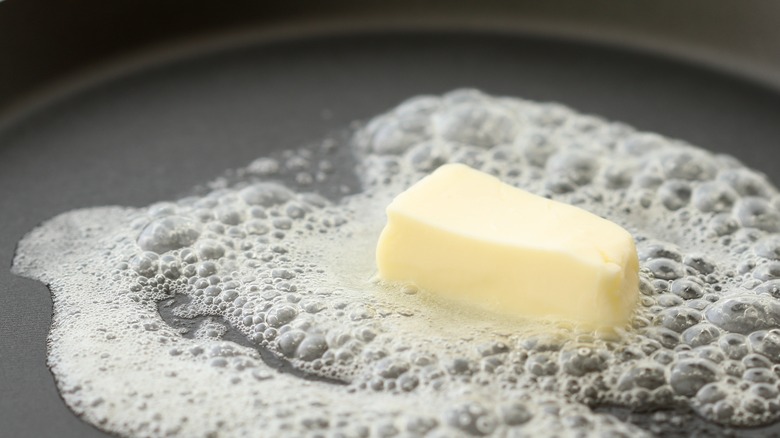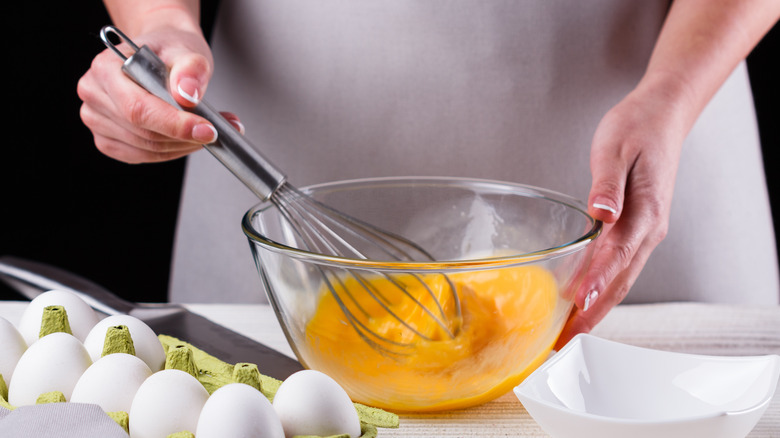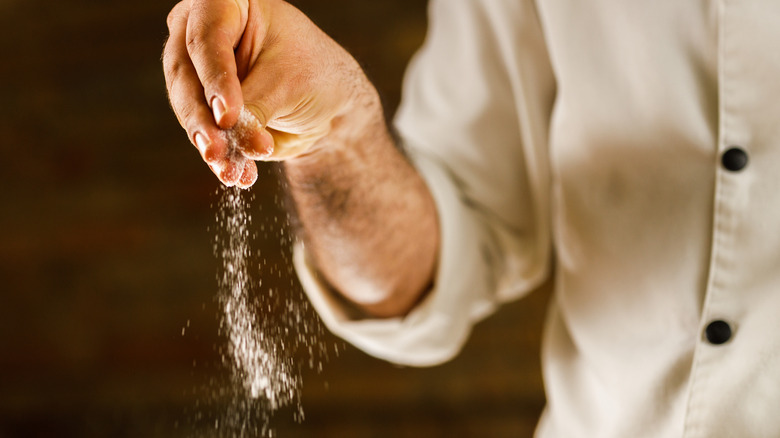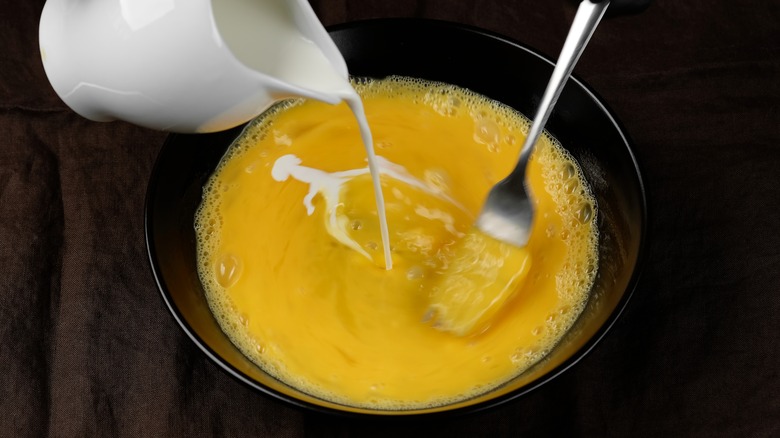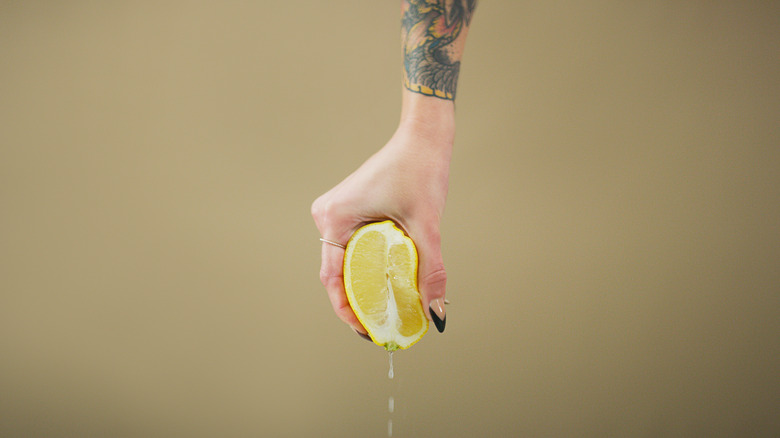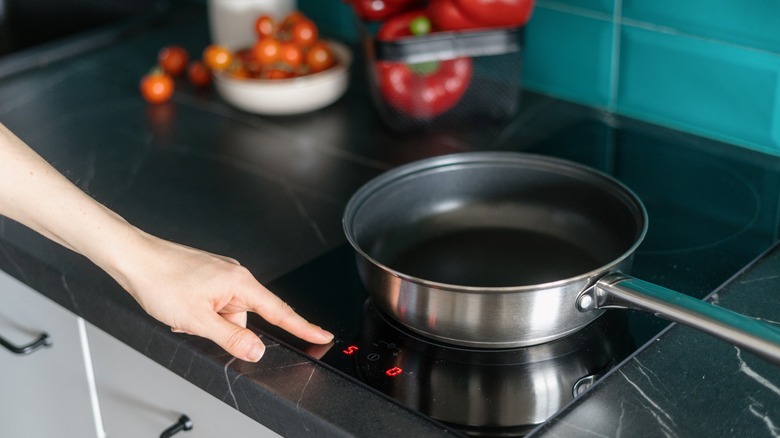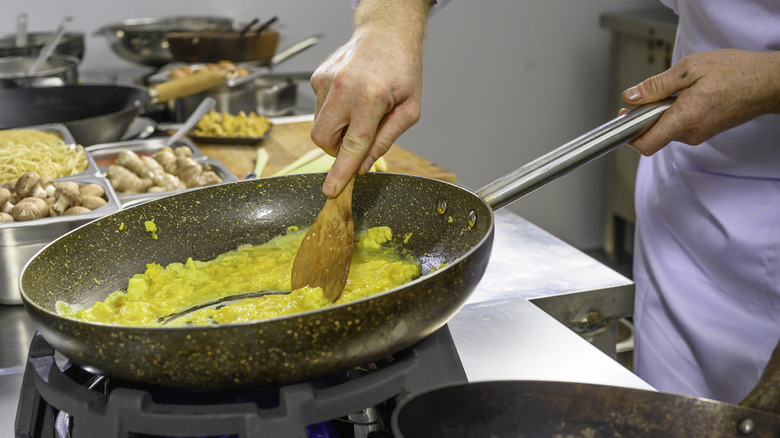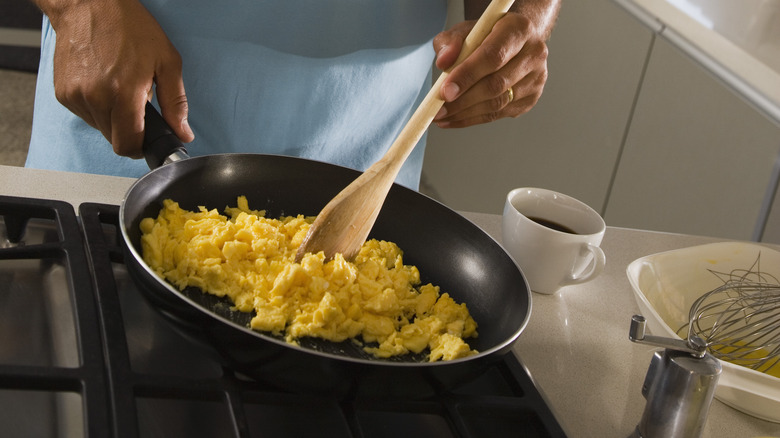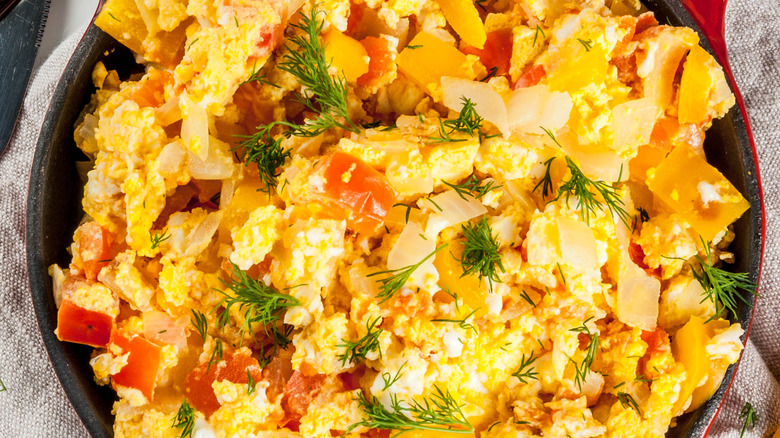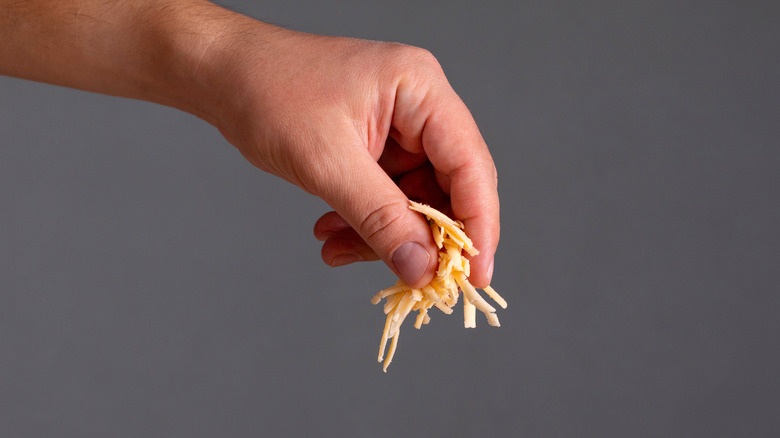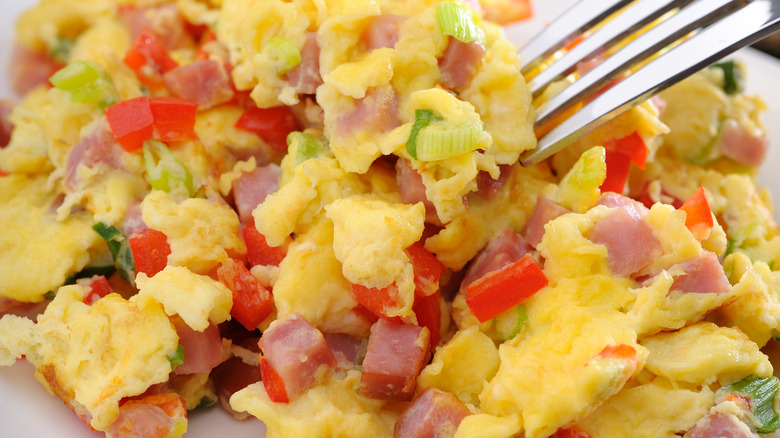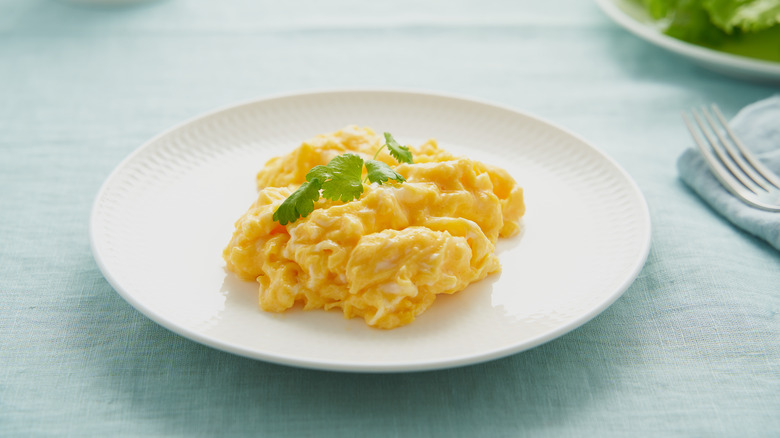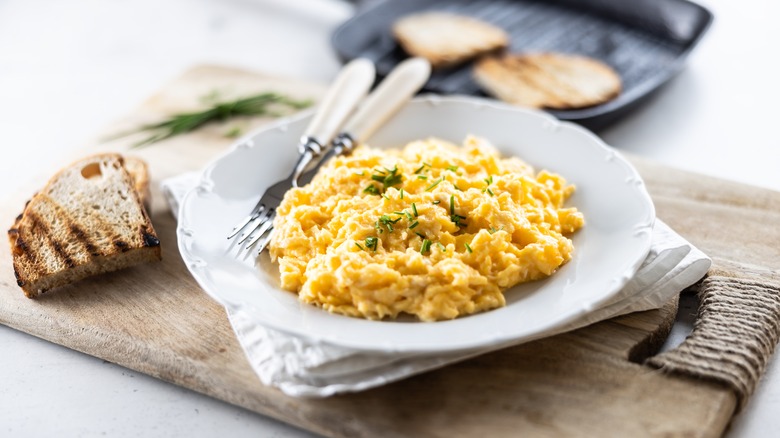Expert Tips On How To Make Restaurant-Quality Scrambled Eggs At Home
We may receive a commission on purchases made from links.
The first time I had to make a cooked breakfast for people other than my immediate family was in the French Alps about a decade ago. I'd already racked up some time in the hospitality industry but predominantly front of house — the only professional cooking I'd done was working at a fast food fry station during high school.
Here I was looking after hosted chalets in a ski resort for the winter, and when a chalet host fell sick one morning, I had to step up and cover in the kitchen. It wasn't that I didn't know how to make a good cooked breakfast, but the standards in these chalets were extremely high, so I dug out the company's recipe guide and flicked to the page on scrambled eggs. Despite its simplicity, the recipe produced the best eggs I'd ever eaten. In the years since, I've managed several restaurants with stellar brunches, and become far more familiar with how the most elegant establishments do breakfasts, and it's probably easier than you think. As you'll see from my tips below, there's no need to splurge on super expensive equipment or overly fancy ingredients to be able to churn out restaurant-quality scrambled eggs at home.
Pick fresh eggs
Most chefs will agree that any dish is only as good as the sum of its parts. The right culinary know-how can make the most out of lower-quality ingredients, but they will hold a meal back from its full potential, especially if they're not fresh.
Anyone who's been unfortunate enough to smell a rotten egg will know why fresh is best, and the more recently laid eggs will have a better flavor and texture. Not everyone has access to farm fresh eggs, so the next best thing is to buy cartons with the latest expiration date, as these should be ones that were produced most recently. You should also familiarize yourself with those confusing egg carton labels, as these will help you identify which eggs have come from chickens that are well-fed and housed humanely. Ultimately, eggs from chickens that are given space to roam outdoors and a nutritious diet are going to taste better and offer more nutritional value.
Use room temperature eggs
Most people keep their eggs in the fridge to keep them fresher for longer and reduce the chance of getting sick from salmonella, especially in the U.S. where manufacturers and distributors have to maintain temperatures enforced by the FDA. Whether or not eggs have to be refrigerated is a debate that still rages but, regardless, there's a good chance your eggs will be cold before you start to cook.
Giving your eggs about 30 minutes to reach room temperature before cooking is beneficial in several ways. First, they'll cook more quickly and evenly, so you're less likely to undercook your eggs or end up with an inconsistent texture. Warmer eggs are also better for mixing, incorporating the yolks and whites more effectively, and emulsifying with cream or milk much more easily. This might not matter if you're boiling, frying, or poaching your eggs, but they're certainly qualities that we want if we're scrambling.
Choose the right cookware and tools
If you've ever had to spend an hour scrubbing away at egg-encrusted cookware, it probably wasn't the right tool for the job. When eggs stick to the pan, they're more likely to burn. It's also harder to fully incorporate the ingredients, and you're going to end up wasting some.
The solution is to use a non-stick frying pan or a well-seasoned cast-iron skillet that will allow you to keep stirring your eggs in order to stop them from clinging to the surface. Bear in mind that using metal whisks, forks, or spatulas to stir your eggs will damage a non-stick coating and ruin the pan, so you'll want an alternative. Wooden utensils are fine but they tend to degrade over time and they can still wear down the pan's surface eventually. Your best bet is something made with high-quality silicone. It's heat-resistant, non-stick, stain-resistant, and easy to clean.
Don't forget the butter
It's been a while since the chef's chef, Anthony Bourdain, publicly outed the amount of butter used in restaurants. Anyone who's not worked in a professional kitchen might be shocked at the quantities, but if you want to cook like the best, it's an ingredient you cannot avoid.
It's not so much that you can't make scrambled eggs with oil instead, but you're going to miss out on everything butter brings to the table. Its milk solids contribute a deep savoriness that oils can't match, and when these begin to brown under the Maillard reaction, they release beautifully rich flavors. The fat in butter also helps create the creamy, smooth consistency we're looking for in our scrambled eggs. If you're trying to avoid fats for whatever reason, you can opt for a neutral cooking oil, but don't expect your eggs to taste as delicious as they do when you order them at a high-end restaurant.
Know the best whisking technique
Believe it or not, there's not really a wrong way to whisk when it comes to scrambled eggs. However, different techniques will produce different results, and getting familiar with these will let you fine-tune your recipe and adjust it to your tastes.
If you beat your scrambled egg mixture with a standard whisk until everything is a consistent color and texture, your eggs will turn out extra fluffy due to all the air that's been incorporated into them. Swapping the whisk for a fork won't introduce as much air to the eggs or combine the yolks and whites quite as thoroughly, so you'll end up with larger curds and denser eggs. The less enthusiastically you mix the eggs together, the denser and richer they'll be. If you haven't tried it before, my personal preference involves skipping the whisking altogether, cracking the eggs directly into the pan, and mixing them together as they cook.
Seasoning is crucial
It's not really fair to claim that eggs don't have a flavor, but the yolk does most of the heavy lifting when it comes to taste, and eggs tend to need a few additions — like butter — to make them shine. The quickest and easiest way to elevate eggs is with seasoning, and a generous pinch or two of salt and pepper is a must for a delicious scramble.
Purists might argue that salt and pepper are all you need, and in my experience, they're not technically incorrect, but there are plenty of other seasonings that can give your scrambled eggs a welcome flavor boost. Used sparingly, garlic and onion powder add a simple complexity to the eggs by introducing new flavors that feel very much like they belong with the rest of the ingredients. You don't want to use anything that completely overpowers the delicate aspects of the eggs and dairy, so less is more. Slightly piquant seasonings like paprika can add a gentle spice, whereas a few dashes of Worcestershire sauce or a small dollop of Marmite will increase the savory umami profile.
Experiment with creaminess
Decadent, creamy scrambled eggs are the best scrambled eggs in my humble opinion, but they're not for everyone, and they may not be ideal if you plan on eating them frequently. The best way to work out how creamy you like your eggs is to experiment with the type and quantity of dairy you add until you know how they're going to affect the final dish.
In France, we used a splash of double cream in our scrambled eggs. It was absolutely delicious as a vacation treat, but maybe not something to eat every day, especially considering the amount of butter in them as well. For some, milk is a better option for everyday eggs as the fat content is lower and, while the texture won't be as rich, it'll still do the job. I'd always recommend using whole milk instead of skim when it comes to cooking, as skim milk is more likely to curdle. While skim milk does have slightly fewer calories than full-fat milk, we're talking about making restaurant-quality eggs here and I can guarantee that professional chefs aren't thinking about calorie counts and using the watered-down stuff.
Add a splash of acid
While you might already be familiar with the idea of using acidic ingredients to balance flavors in cooking, they can have additional chemical effects on how foods cook. With scrambled eggs, a little lemon juice or vinegar will actually give you softer eggs, even if you don't add enough to impact the taste.
Eggs are protein-rich, and the acid reacts with these proteins in a way that means they start to denature at a lower heat when cooking. It also helps them form into a solid while creating little pockets of air in the egg mixture, the result being scrambled eggs with a much fluffier texture. As a rule of thumb, a teaspoon of lemon juice or vinegar for every two eggs should be enough to give you softer scrambled eggs without affecting the overall flavors, but you may want to experiment and tweak the amount to your preferences. If you do want to adjust the flavor — for example, brightening the eggs with citrus — you can add more to your egg mixture before cooking or add an extra splash when the eggs are done just before serving.
Cook scrambled eggs low and slow
Eggs are delicate, and cooking them at high temperatures is completely unnecessary. If your pan is too hot, there's a good chance you're going to overcook your scrambled eggs.
Before you even add the eggs, a pan that's too hot can burn your butter, so things will already be off to a poor start. When you do add your eggs, if they hit a pan that's too hot they'll start becoming over-browned and crispy within moments, and you'll notice unappealing brown streaks start to appear as you begin stirring. Even if you avoid burning anything, overcooking the eggs will dry them out and they'll lose the creamy texture you worked hard to create. Generally, low and slow is the way to go, but you can still adjust your temperatures for different results. Higher heat will produce steam when the eggs go in, which will lead to fluffier scrambled eggs, while lower heat will keep them creamier and more dense.
Don't over or under stir
When your eggs are cooking, you'll want to stir them so they cook evenly throughout, producing delicate curds that don't stick to the bottom of the pan. Remember, you should have already combined your egg mixture to the desired consistency, so we're not really trying to introduce any more air here.
In fact, I don't even really call what I do "stirring" — it's more like agitating the eggs. Once the mixture is in the pan, leave it for about 30 seconds, or as long as it takes for the bottom of the eggs to look like they've just coagulated. Then, with a silicone spatula, it's time to swirl the egg mixture around a few times, wait a few moments, and repeat. If you're breaking the eggs directly into the pan, you'll also want to break the yolks at this point, add your dairy, and give them an extra stir to combine the ingredients.
Timing is key
Even at lower temperatures, eggs cook rather quickly. Realistically, scrambled eggs don't need more than about a minute in the pan per egg, so while they're not something you should take your eye off during cooking, you shouldn't need to.
Scrambled eggs will continue to cook in a hot pan and even from residual heat when they're removed from the pan, so you want to take them away from the heat source slightly before they're set and ready. It might seem a little unappealing at first if they look slightly undercooked, but by the time they're plated up, they should have had enough time to finish setting. If you don't take scrambled eggs away from the heat source until they look perfectly ready to eat, they'll usually end up overcooked by the time you take your first bite. In that case, they'll be dry and spongy rather than fluffy and creamy.
Don't overcrowd the pan
Because eggs are delicate when it comes to applying heat, overcrowding the frying pan or skillet will make it much harder to get them evenly cooked throughout. You're more likely to end up with bits of under or overcooked egg, and if the volume of your mix is too great for the depth of your pan, be prepared to clean up spilled egg mixture once you're done.
If you're making a large amount of scrambled eggs for a group of people, the trick is to cook in batches. Feel free to mix all of your eggs in one large bowl, but know that combining the ingredients sufficiently and fluffing them up enough will take a little more elbow grease. Eggs cook quickly enough that you're not really losing much time by making the scramble in batches, and certainly not as much as you'd lose if you had to remake a large batch that was unevenly cooked. The main thing to remember is to ensure the pan is completely empty between each batch so the later portions don't end up with burned egg in them. You'll also want to add a little more butter to the empty pan each time.
Add cheese at the right time
While scrambled egg recipes don't always call for cheese, it's the perfect ingredient for complementing both the flavor and texture of the dish and there are plenty of great ones to choose from. Whichever you pick, the key is to add the cheese at the right time during the cooking process — and that means not too early.
If you mix the cheese in straight away, one of two things might happen: either the cheese "sweats" and becomes greasy or it burns in the pan. The trick is to wait until the eggs are nearly completely cooked before adding cheese and letting the residual heat do most of the work melting it. It's hard to give a specific time because there are some factors that can vary, such as the type of cheese you're using and how much of it you want to add. Harder cheeses like cheddar might take longer to melt, so it's best to make sure they're well-grated before you add them, whereas Swiss cheese and Gouda tend to melt more easily.
Try different ingredients
Although too many extra ingredients will eventually detract from the delicate flavors of restaurant-quality scrambled eggs, it's always worth experimenting with tasty additions. Adding meat, vegetables, or even fish can be an excellent way to make your eggs more exciting and increase their nutritional value.
Diced ham or bacon will bring a salty umami taste to scrambled eggs, and sauteed mushrooms are a great veggie alternative for the same effect. Fresh vegetables like bell peppers or spring onions add a bright and zingy crunch. Meanwhile, smoked salmon and scrambled eggs are a match made in food heaven. Like with the cheese, you'll need to consider when you add any extra ingredients. For example, things like smoked salmon and spring onions are best added at the very end because we don't really want them to cook with the eggs. Other ingredients may need to be prepared in advance, as they won't have enough time to cook fully with the eggs.
Garnish for the best presentation
There's a common saying in the culinary world about how we take the first bite of food with our eyes. Clearly, that's not meant literally, but most of us start experiencing a dish the moment we lay eyes on it which is why presentation is so important. Now, there's not a whole lot you can do in terms of physical presentation with scrambled eggs besides trying not to make a huge mess on the place. This is where garnishes come in.
You want to make the dish stand out, so it's best to use something with a color that contrasts with the golden yellow of the eggs. Parsley or chives are common picks because they add a fresh green pop and a complementary taste. If you're using fresh ingredients in your recipe, you can also add these for a garnish. Ultimately, it's the perfect way to boost the flavor of your scrambled eggs and turn them from looking like a yellow blob into something that came out of a professional kitchen.
Serve immediately
I'd probably go as far as saying that, when made the right way, scrambled is my favorite style of eggs; however, it's crazy how awful they can get when they've been left too long before serving. When they cool and set, the experience can be like eating an old kitchen sponge. It's possible to keep scrambled eggs warm for a crowd in the oven on low heat or in a slow cooker, but I'd still argue the quality dips after the first few minutes.
Simply put, the best scrambled eggs are the ones that are fresh out of the pan. As mentioned above, by the time they've cooled enough to put in your mouth, the residual heat will have cooked them to perfection and the flavors should have melded completely. If you've added cheese, it'll still be nice and gooey and not have had a chance to re-solidify into a rubbery texture. Finally, make sure you serve scrambled eggs on a warm plate that's been heated gently in the microwave or in hot water to preserve them for even longer. They'll maintain their creaminess, and give you time to savor your whole meal!

